Listening to your customers is vital, especially in social media marketing.
Social media is a high-value ground for brands, and with the right social listening metrics, marketers today can garner valuable insights to create a marketing strategy that promises exceptional results.
Social media is ever-expanding. Currently, 58.4% of the world’s total population uses social media, that’s about 4.62 billion users. The year-on-year growth rate of social media users is just over 10%, which is phenomenal.
While these users spend hours connecting with their friends and family, they also use social media to research brands, share their experiences, and influence each other’s decisions.
💡 Read Social Listening Guide: Proven Hacks, Strategies, and Tools
As a brand, it is essential to understand what your customers are saying about you.
Enter social listening.
The more you understand what your audience wants, the better you will cater to their needs. From tactical guesswork, social listening moves you to make more data-driven decisions for product and business development.
With a plethora of unstructured social data to be analyzed, you need to be sure of which social listening metrics you want to track to derive the right business KPIs.
In this post, we will be looking into 5 key social listening metrics you should track to understand what your customers want and how to improve your conversion rate.
Let’s get into it.
What is Social Listening?
Social listening refers to a process of analyzing social media conversations around your brand and in general around your niche or industry.
It is a two-part process where you:
- Monitor all the conversations and brand mentions on social media to measure your brand reputation.
- Analyze these conversations to create more tailored responses.
By continuously tracking real-time data, social listening can help you understand where, how, and why people are talking about your brand or products.
The insights you derive will help you build a better relationship with your existing customers and customize your social media campaigns to attract leads.
You can then use a powerful lead generation software to convert these leads into paying customers, leading to business growth.
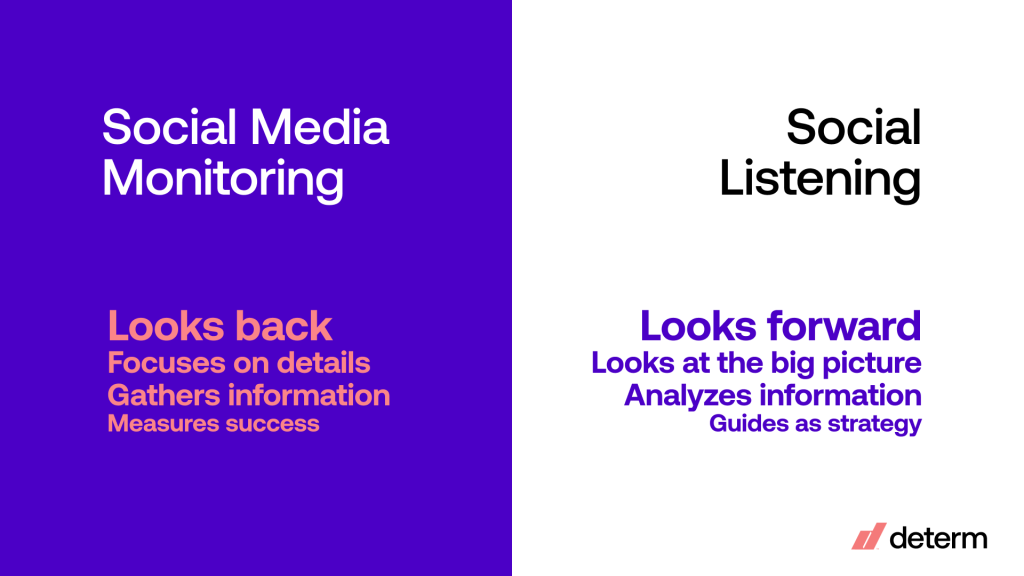
Social listening has a broader scope compared to social monitoring. In social listening you measure things like:
- Brand mentions
- How well people recognize your brand
- What your customers feel about your products and customer service
- How likely they are to recommend your products to their connections
- Leads generated
Brands that understand how to leverage the power of social listening can stay ahead of their competitors and propel their business on the path to success. And according to a research on PR statistics, 46% of brands use social listening as a data collection method.
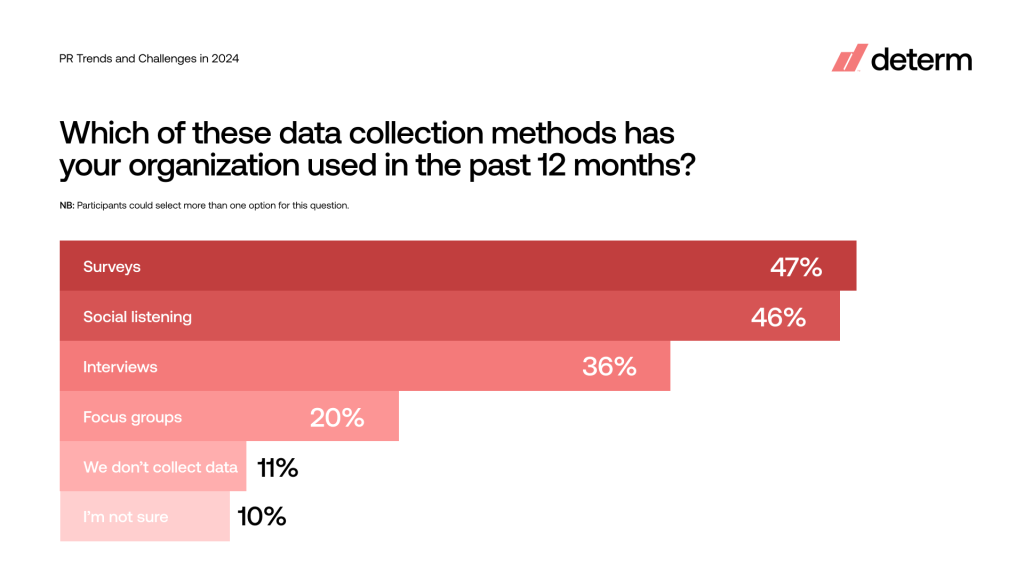
Read Complete Guide to Social Listening: Proven Hacks, Strategies, and Tools
Top 5 Social Listening Metrics to Follow
Social listening can offer multiple benefits if you know which metrics to track.
If you are in a fix as to which ones are beneficial for your brand, these 5 must-track metrics are a good place to get started.
1. Mentions
How familiar are your audiences with your brand? That’s what brand awareness is all about. And the metric we track to measure this KPI is brand mentions.
To measure the level of your brand awareness, track the number of mentions and the reach of mentions. The combined data from these 2 social listening metrics will help you understand your brand’s reach online.
Let’s say, you have launched a new product, used Google ads and other advertising channels to put the word out about the product, and now you want to quantify its popularity.
You can list down all the related keywords and set alerts for them. The number of mentions you score indicates the level of awareness you were able to create for that new product.
However, in social listening, it is not enough to count @mentions. Measure how many times social media users made reference to your brand or product in their conversations.
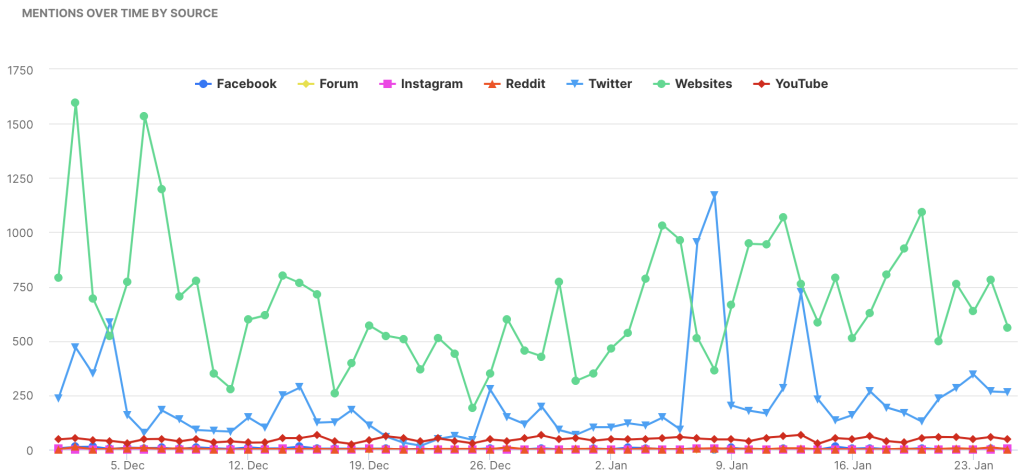
Along with measuring the volume of mentions, you also need to monitor their reach, meaning how many people were able to see your brand name.
A mention by an influencer or a celebrity will have more reach than a regular user. This means brands can achieve greater reach even with lesser mentions.
Measuring these metrics will help determine how successful a marketing campaign was and the areas you need to work on.
2. Engagement
Social media engagement is one of the most commonly tracked social listening metrics. It encompasses a variety of user activities including:
- Likes
- Comments
- Shares
- Follows
- Direct interaction with a brand via direct messages
These actions can be interpreted as a nod for your product or brand, saying a warm hello, appreciating your efforts, or a willingness to stay connected with you. No matter the gesture, social media engagement is a stepping stone for lead generation.
When you monitor engagement, you will be able to co-relate it to your social media conversion rate. The stronger the engagement, the better your chances of lead generation for your business.
Monitoring engagement is extremely essential in devising a strategy that builds a strong relationship with your existing and potential customers. After all, you don’t want your customers to buy from you once. Your target is to turn them into loyal customers.
What’s more?
There’s a lot that you can figure out from your audience engagement on social media too, especially comments. For instance, if you’ve put up a video on social media, there may be certain parts about it that your audience may not like.
If you notice them writing about this in the comments, you could cut the video and upload it again. This would help in generating further engagement as your audience would get exactly what they wanted.
Read 5 Clever Ways to Improve User Engagement
3. Sentiment Score
As we are talking about social listening metrics, it’s not only important to monitor numbers but to understand user sentiments as well.
Let’s remember, while many of the mentions on the internet are from happy customers, there are those from dissatisfied or disappointed customers too.
A sentiment score is a social listening metric that tells you how happy your customers are with your brand. Customer satisfaction or CSAT is an important KPI to affirm that your products and customer service are satisfying your customers.
Let’s assume you have launched a YouTube video editing tool, for instance. And you’ve had a good number of users subscribe to it. By analyzing sentiments, you will be able to gauge how happy and satisfied your customers are with the tool.
Why is a customer sentiment score more valuable than your usual surveys? Because when people share their sentiments on social media, they are unbiased and self-motivated to express their opinions. More often than not, they are genuine.
By categorizing the mentions as positive, negative, and neutral tones, you can analyze the extent of your brand’s popularity.
It also helps you spot negative sentiments early and resolve the matter quickly.
For instance, you can improve positive sentiments by showing customers that you understand their needs. One way to achieve this is by using customer data from your email list management software to provide personalized social media experiences to the people on your email list.
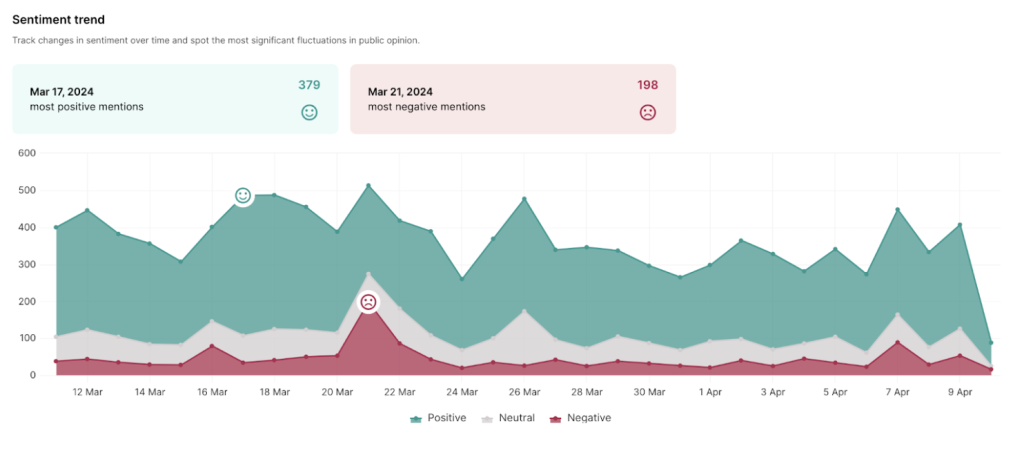
4. Net Promoter Score
Most of the social listening metrics that we are discussing today are all interconnected. When put together they give you a clear picture of your brand’s reputation online.
If sentiment tracking tells you how happy or satisfied your customers are with your products, the net promoter score tells you how likely these happy customers are to recommend your products to their connections.
If you are running a referral program, the net promoter score will help you measure how many leads you were able to generate.
Based on this score you can shortlist your brand advocates and influencers who can help you market your products and influence more users to try them.
5. Share of Voice
You operate in an extremely busy market and your competitors too are working hard to impress the target audience that you are focusing on. That’s why one of the most important social listening metrics is the share of voice.
Share of voice involves comparing your reputation with that of your competitors.
This report generated using Determ’s Online Media Monitoring Software, shows a competitive analysis of Zara and Bershka. It’s evident that Zara has a greater share of voice than Bershka.
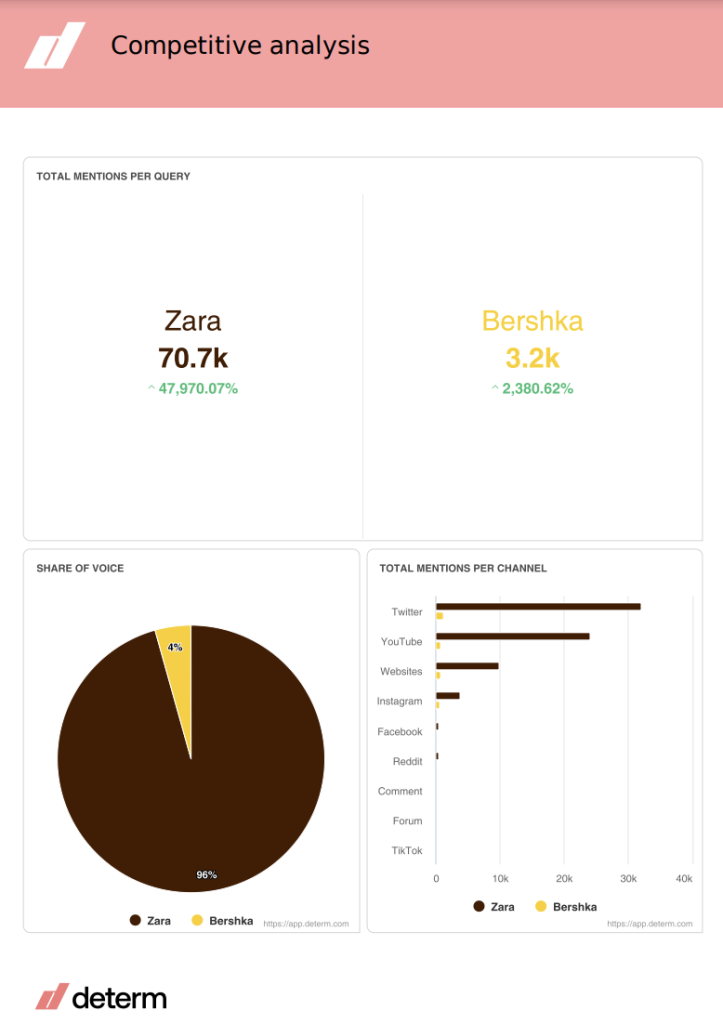
Thus, social listening tools can help you analyze your brand presence and awareness with that of your competitors on top social media platforms. Based on the insights collected, you can tweak your marketing strategy to impress your audience more.
Read How to Use Media Monitoring for Competition Analysis
Are You Ready to Leverage the Benefits of Social Listening Metrics?
There you have it, the top 5 social listening metrics you need to track if you want to draw the right insights.
Read Top 5 Media Monitoring Metrics That Matter
Businesses often focus on creating strong marketing strategies but can easily ignore determining the right KPIs. These social listening metrics will help you focus on the right business KPIs to measure how successful your campaigns have been.
Effective social listening tools can help simplify the whole process for you.
Go ahead and track these metrics to measure the KPIs that really matter to you. It’ll help you make more data-driven decisions to grow your business.
If you’d like to find out more about metrics in Determ that could make your business, book a demo, we’d be happy to help you out.
Gaurav Sharma is the founder and CEO of Attrock, a results-driven digital marketing company. Grew an agency from 5-figure to 7-figure revenue in just two years | 10X leads | 2.8X conversions | 300K organic monthly traffic. He also contributes to top publications like HuffPost, Adweek, Business 2 Community, TechCrunch, and more.